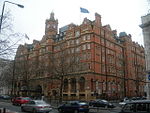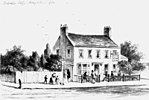Marylebone station

Marylebone station ( (listen) MAR-li-bən) is a Central London railway terminus and connected London Underground station in the Marylebone area of the City of Westminster. On the National Rail network it is also known as London Marylebone and is the southern terminus of the Chiltern Main Line to Birmingham. An accompanying Underground station is on the Bakerloo line between Edgware Road and Baker Street in Transport for London's fare zone 1. The station opened on 15 March 1899 as the London terminus of the Great Central Main Line (GCML), the last major railway to open in Britain for 100 years, linking the capital to the cities of Leicester, Sheffield and Manchester. Marylebone was the last of London's main line termini to be built and is one of the smallest, opening with half of the platforms originally planned. There has been an interchange with the Bakerloo line since 1907, but not with any other lines. Traffic declined at Marylebone station from the mid-20th century, particularly after the GCML closed. By the 1980s, it was threatened with closure, but was reprieved because of commuter traffic on the London to Aylesbury Line (a remaining part of the GCML) and from High Wycombe. In 1993 the station found a new role as the terminus of the Chiltern Main Line. Following the privatisation of British Rail, the station was expanded with two additional platforms in 2006 and improved services to Birmingham Snow Hill. In 2015 services began between Marylebone and Oxford Parkway via a new chord connecting the main line to the Oxford to Bicester Line and an extension to Oxford following in 2016. As of 2020, it is the only main London terminus to host only diesel trains, as none of the National Rail lines into it are electrified. Marylebone is one of the squares on the British Monopoly board, and is popular for filming because of its relative quietness compared to other London termini.
Excerpt from the Wikipedia article Marylebone station (License: CC BY-SA 3.0, Authors, Images).Marylebone station
Melcombe Place, London Marylebone
Geographical coordinates (GPS) Address Nearby Places Show on map
Geographical coordinates (GPS)
| Latitude | Longitude |
|---|---|
| N 51.5223 ° | E -0.1634 ° |
Address
Victoria & Albert
Melcombe Place 131-151
NW1 6JJ London, Marylebone
England, United Kingdom
Open on Google Maps










